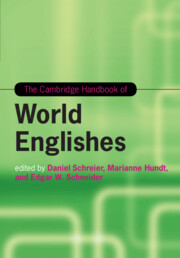Book contents
- The Cambridge Handbook of World Englishes
- Cambridge Handbooks in Language and Linguistics
- The Cambridge Handbook of World Englishes
- Copyright page
- Dedication
- Contents
- Figures
- Maps
- Tables
- Notes on Contributors
- 1 World Englishes: An Introduction
- Part I The Making of Englishes
- 2 The Colonial and Postcolonial Expansion of English
- 3 Theoretical Models of English as a World Language
- 4 The Contribution of Language Contact to the Emergence of World Englishes
- 5 Population Structure and the Emergence of World Englishes
- 6 World Englishes, Migration, and Diaspora
- Part II World Englishes Old and New
- Part III Linguistics and World Englishes
- Part IV Current Challenges
- Index
- References
3 - Theoretical Models of English as a World Language
from Part I - The Making of Englishes
Published online by Cambridge University Press: 16 December 2019
- The Cambridge Handbook of World Englishes
- Cambridge Handbooks in Language and Linguistics
- The Cambridge Handbook of World Englishes
- Copyright page
- Dedication
- Contents
- Figures
- Maps
- Tables
- Notes on Contributors
- 1 World Englishes: An Introduction
- Part I The Making of Englishes
- 2 The Colonial and Postcolonial Expansion of English
- 3 Theoretical Models of English as a World Language
- 4 The Contribution of Language Contact to the Emergence of World Englishes
- 5 Population Structure and the Emergence of World Englishes
- 6 World Englishes, Migration, and Diaspora
- Part II World Englishes Old and New
- Part III Linguistics and World Englishes
- Part IV Current Challenges
- Index
- References
Summary
World Englishes (WEs) research has developed into one of the most flourishing and vibrant fields of linguistic inquiry. To capture the sociolinguistic diversification of English, researchers have investigated a multitude of Englishes spoken around the globe as native or second languages. Together with different labels and terms for the different varieties of English, scholars have developed, applied, discussed, and refined different models of and approaches to WEs to account for the spread, forms, and functions of the language worldwide. The chapter gives an overview of the most important research developments in the field and introduces the most prominent models, showing that models with a diachronic dimension, viz. Schneider (2003, 2007) and, most recently, Buschfeld and Kautzsch’s (2017) Extra- and Intra-territorial Forces (EIF) Model, can best account for the complex realities and developments of English worldwide. The latter approach is discussed in some detail as it constitutes the most recent addition to the WEs paradigm. It stands out due to its attempt to integrate postcolonial and non-postcolonial Englishes and thus bridges a prominent gap in the discipline.
Keywords
- Type
- Chapter
- Information
- The Cambridge Handbook of World Englishes , pp. 51 - 71Publisher: Cambridge University PressPrint publication year: 2020
References
- 2
- Cited by

